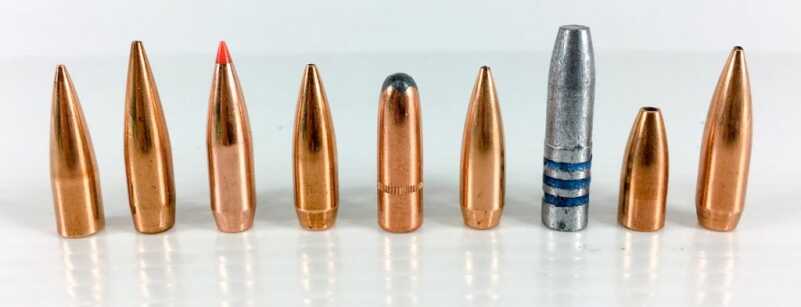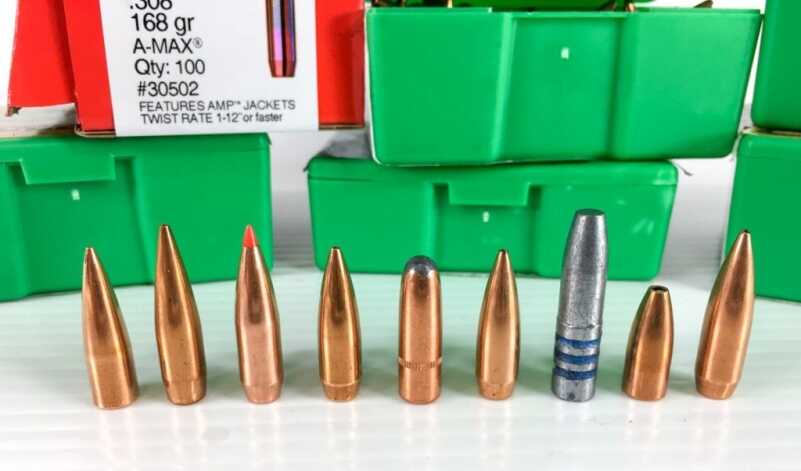SERIES
Part 1: Want to Reload Your Own Ammo? Basic Questions to Consider
Part 2: The Reloading Process
Part 3: The Gear You’ll Need and What It’ll Cost You
Part 4: Brass Cleaning and Preparation to Load
Part 5: Brass Resizing
Part 6: Trimming Cartridge Cases
Part 7: Repriming the Cartridge Case
Part 8: Powder, Propellants, and Pressure
Part 9: All About Primers
Part 10: Projectiles: Materials, Weights, and Styles
Part 11: Seating and Crimping Bullets
Part 12: To Crimp or not to Crimp
Part 13: Final Inspection and Packaging Tips
Bullets are bullets, right? Well, not really. There are a wide array of variables in bullet shape, weight, materials, and construction. Each of these variables can have a dramatic impact on the performance, and safety, of any given load. In other words, loading recipe data for one 147-grain, .308 bullet may be incorrect, and even unsafe, for another projectile of equal caliber and weight.
Let’s take a closer look at some of the variables and what you need to know about each.
Materials
Long ago, the universe of bullet materials could be summed up in one word: lead. Now, we can choose all lead, lead alloys, copper-jacketed lead, plated lead, coated lead, all-copper, compressed powder frangible, and even polymer and copper blend bullets. You’ll even find ammo with made up metallic names that sound like the stuff that powers the Starship Enterprise.
Even among bullets with the same overall weight, performance can vary widely, often as a result of friction as a bullet travels down the bore. As a simple example, it’s easier to push a soft lead bullet down the barrel than a hard copper jacketed one.
Jacketed
Jacketed bullets have a comparatively hard copper or copper alloy exterior. Usually, lead interior cores are stuffed into this hard jacket during the bullet construction process. The intent behind this design is to have a bullet that’s as heavy as possible for its size because the bulk of the interior is made of dense lead. The copper jacket adds strength and allows the bullet to be forced down the barrel at higher velocities. Under higher pressure and velocity, lead bullets would melt and deform. Since the jacket is tougher, more force is required to drive a jacketed bullet through the rifling, so, generally speaking, you’ll see larger powder charges stated in load recipes than for a comparable weight lead bullet.
Lead
As lead is softer and squishier than copper, it’s easier to push through rifling in the barrel. Most load recipes for same-weight bullets will be about 10% less than those for copper-jacketed projectiles. The 10% figure is a rule of thumb, so always check specific load data rather than relying on that number – it’s just a guideline.

Even though that huge lead bullet towards the right is much heavier than all the others, it doesn’t take much of a charge to drive it through the barrel. Of course, it’s also designed to be subsonic.
A note on barrel leading…
Lead bullets (usually made by adding other metals like tin or antimony if different proportions) can, in certain cases, leave excessive lead residue in gun barrels. Whether a lead bullet will cause “leading” in the barrel isn’t so simple as being a result of a bullet being too soft. In reality, whether a bullet in a given load will lead the barrel or not is usually a function of pressure and bullet hardness. In other words, using a harder bullet, in some situations, can cause more leading than the use of a softer one. Here’s why.
A lead bullet is designed to expand or obturate slightly under pressure from the hot gas blast behind it. The idea is that the lead base expands into the rifling of the barrel, preventing hot gas from slipping by. This seal helps create maximum efficiency of a given load and powder charge. If a bullet is too soft for the pressure level of a given charge, the base will melt and leave a mess in the barrel. If the bullet is too hard, the base won’t expand and seal the bore, so hot gasses blow by the bullet, melting the sides and leaving excessive leading. You want to match the hardness of your projectile to the anticipated pressure of the load.
Plated
On the outside, plated bullets look like jacketed ones, but there’s an important difference. A plated bullet is manufactured by chemically and electronically applying a “coat” of copper jacketing material to the outside of a lead projectile. As a result, the “jacket” is much thinner and softer than that of a true jacketed bullet. Plated bullets won’t handle the same pressure and velocity of jacketed counterparts, although we’re starting to see some new plated designs that have thicker plating.
Regarding performance, a plated bullet performs more like a lead one of identical shape and size and usually requires a powder charge similar to a lead bullet. A rule of thumb is that many plated bullets use a charge weight about 10% less than that of an identical jacketed bullet. Don’t rely on that math – it’s just for informational purposes. Always check with the bullet manufacturer to find the correct charge.
Bullet Shapes
It’s important to recognize that bullet weight isn’t everything. That means that you can’t necessarily use the same powder charge for different bullets of the same caliber and weight – you also have to consider the shape of the bullet.
The shape defines how much of the bullet contacts the rifling as it travels down the bore. The more surface area contact, the more force is required to move the bullet through the rifling. If one bullet shape is harder to push through the bore, there’s going to be a higher pressure buildup behind it.
To illustrate this point, think about pushing two objects through a cannon – a football and a giant #10 can of lima beans – you know, those giant ones you find at places like Sams Club. Assuming that the widest part of the football and lima bean can are identical in diameter, it’s clear that there is much more surface area contact between the lima beans and tube than there is with the football. As the football is sharply tapered at both ends, only the very widest section in the center of the ball will contact the barrel walls. Since the lima bean can is a cylinder, the entire can will create friction against the inside of the National Vegetable League cannon barrel. Even if the football and ballistic vegetables weighed exactly the same, it’s going to take more pressure to launch the beans at the same velocity.

Look at the difference in “bearing surface” area between these three. The round nose, being more cylindrical, generates a lot more friction than the other two.
It’s exactly the same with bullets. Round or flat nose bullets are more cylindrical in shape, so much more of the length of the bullet will scrape against the rifling. On the other hand, an aerodynamic ballistic tip boat tail bullet only has a small section in the middle that contacts the rifling so it will operate with less pressure.
You’ll even find some bullet designs with driving bands. Rather than a smooth surface that contacts rifling, some bullets have grooves cut in the bodies. These grooves reduce surface area contact, which minimizes friction. The idea is to create more velocity with a given powder charge or allow a larger powder charge without an increase in pressure.

The folks at Barnes Bullets use driving bands made by cutout rings to reduce bearing surface and friction.
Summing it up
All bullets are not the same, even if they are the same caliber and weight. The hardness (read friction) of the bullet and the amount of surface area contact can both have big impacts on the pressure level of any given load. It’s yet another reason to stick to published loading information exactly – don’t make assumptions.


In the first sentence of the second paragraph of the subsection titled “Plated”, does the author mean “plated” rather than “jacketed”? If not, the second sentence seems to contradict it. I’m reading this from atop a high pinnacle of ignorance. So someone with more knowledge help me out. Mr. McHale?
Yes thanks fixed it.
Oops! Thanks for the catch!
I see it as two separate things ,described as Plated, being Copper Plated, and Jacketed, being the true Jacketed , lead core,contained within a Copper jacket.
Nice article . I love stuff about reloading. I have been reloading since 1980 and have no idea how many rounds I have made in that time. But I do remember shooting 600 rounds a week for IPSC practice for several seasons and many more for hunting and plinking. My real comment is about shooting lead. I was wondering why there was no mention of bullet speed in relation to barrel leading. I know this article wasn’t just about handgun rounds but over the years I have found that lead pistol bullets held under 1000 fps left very little lead. Again I can’t speak for higher velocity rifles as I mostly load .38, .357, .44mag and a few jacketed bullets in 30-06. I shoot a 158 gr, SWC lead at 850 fps that will hold 2″ groups at 50yds from a S&W 586, 8″ w/4x scope and leaves no real lead to worry about. I have made jacketed loads that went under 2″ at 75yrds from sandbags with this gun. If you shoot you should learn to reload. A great satisfaction in making your own ammo that shoots like this.
Excellant article.
Sorry, but you left out the newish plastic coated bullets! I have tried 9mm and 38 ‘lipstick’ style (called by Acme bullets) and they shoot very well! No leading, no splash back from steel and less smoke and air borne lead at the same price as there plain cast bullets!
I think it might be cool to take a very close and pseudo-scientific look at “non-traditional” bullets like polymer-coated, moly, frangible, etc as you and Lee and Jeff suggest. I’ll pester the powers that be to let me out of my cage at some point to explore this further 🙂
Always nice to see reloading articles and really don’t see enough. This was like intro to reloading 101, bullets, and really a nice general read and I’m sure not meant to cover everything. Keep up the good work and more articles on reloading please.
Don’t forget polymer coated (Blue bullets, Bayou Bullets, Precision bullets, etc…) lead bullets, and solid copper alloy (Barnes TSX, Hornady GMX, Warne Tool, Flatline bullets. Both very popular
Would have like powder coating included in this article. Good general read. Thanks
Didn’t see any mention of the poly coated bullets. Such as Badman makes . Also glad to see articles on reloading
Nice to see more reloading articles. Keep them coming.